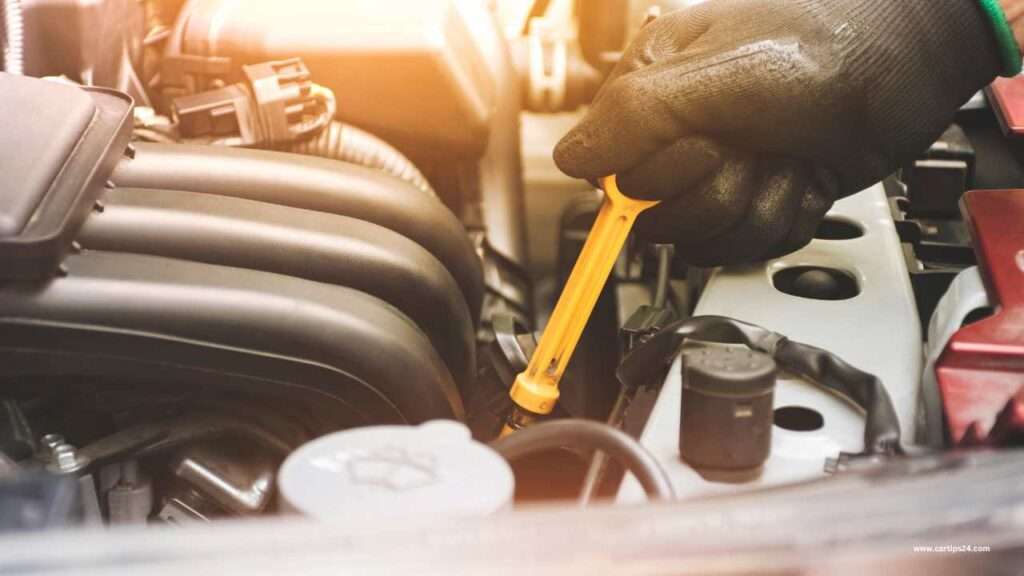When it comes to vehicle maintenance, one of the most common questions is, ‘How Much Oil Does My Car Need?’ Understanding your car’s specific oil requirements is essential for its long-term performance
Maintaining your vehicle is essential to keep it running smoothly, and one critical aspect of car maintenance is ensuring your engine has the correct amount of oil. Think of engine oil as your car’s lifeblood – it lubricates the engine’s moving parts, regulates temperature, cleans, and seals, ensuring your engine functions optimally. But the question remains: how much oil does your car really need? In this comprehensive guide, we’ll delve deep into the factors that determine your car’s oil requirements, providing you with valuable insights to keep your engine running like a well-oiled machine.
Understanding Engine Oil

Before we dive into the specifics of oil quantities, let’s grasp the fundamental role of engine oil:
1. Lubrication
Engine oil acts as a lubricant, reducing friction between various engine components. As the engine operates, multiple parts move rapidly and create friction. Oil steps in as the silent hero, preventing wear and tear, and ensuring the engine runs smoothly.
2. Cooling
In addition to lubrication, engine oil plays a crucial role in cooling. Engines generate immense heat during operation. Engine oil aids in dispersing this heat, effectively averting overheating and safeguarding the engine from potential damage.
3. Cleaning
Engine oil also acts as a cleaning agent. It collects dirt, debris, and contaminants that accumulate within the engine over time, preventing the formation of harmful sludge.
4. Sealing
Furthermore, engine oil forms a protective seal within the engine. It prevents combustion gases from escaping and maintains proper compression, ultimately contributing to engine efficiency.
Determining Car’s Oil Capacity to know How Much Oil Does My Car Need?

Now, let’s explore the factors that determine the quantity of oil your car requires:
1. Engine Size
The size of your car’s engine is a primary factor in determining oil capacity. Larger engines typically demand more oil to ensure adequate lubrication of all components. To find the specific oil capacity for your engine, consult your owner’s manual or refer to online resources.
2. Manufacturer Recommendations
Car manufacturers provide comprehensive information regarding oil capacity and oil type in the owner’s manual. It’s crucial to adhere to these recommendations, as they are tailored to your vehicle’s precise requirements, guaranteeing optimal engine performance and longevity.
3. Oil Viscosity
Oil viscosity, often represented by a combination of numbers and letters (e.g., 10W-30), indicates the oil’s thickness and flow characteristics. Different engines necessitate varying oil viscosities. Using the correct viscosity is paramount to ensuring proper lubrication. The owner’s manual typically specifies the suitable viscosity for your car.
4. Oil Change Interval
The frequency of oil changes significantly affects the amount of oil your car requires. Regular oil changes are crucial to maintain engine health by eliminating old, contaminated oil. Review your owner’s manual for recommended oil change intervals, and follow them diligently.
Checking Your Car’s Oil Level


To guarantee your car has the appropriate oil level, follow these simple steps:
1. Park on Level Ground

To obtain an accurate reading, park your car on a flat, level surface. This ensures that the oil settles uniformly within the engine.
2. Warm Up the Engine

Start your car and allow it to idle for a few minutes, enabling the oil to reach an optimal temperature. Warmer oil exhibits improved flow characteristics, resulting in a more accurate measurement.
3. Locate the Dipstick

Open the hood of your vehicle and locate the engine oil dipstick. This component usually features a brightly colored handle and is labeled “Engine Oil.”
4. Remove and Wipe

Carefully remove the dipstick, using a cloth or paper towel to wipe it clean. Reinsert the dipstick fully to ensure an accurate reading.
5. Check the Level

Withdraw the dipstick once more and inspect the oil level. The dipstick will have “Full” and “Low” marks. Ideally, The oil level should ideally rest between these two markers. If it falls below, simply add the recommended oil type until it reaches the “Full” mark.
Conclusion
Maintaining the correct oil level in your car’s engine is paramount for its longevity and optimal performance. By comprehending your car’s oil capacity and regularly monitoring the oil level, you can ensure your engine runs smoothly for years to come.
FAQs (Frequently Asked Questions) for How Much Oil Does My Car Need?

1. How often should I inspect my car’s oil level?
It’s advisable to check your car’s oil level every month or before embarking on long journeys. Routine checks help prevent engine damage due to low oil levels.
2. Is it permissible to utilize any variety of engine oil in my car?
No, it’s imperative to use the oil type recommended by the car manufacturer. Consult your owner’s manual for specific details, as using the wrong oil can harm your engine.
3. What happens if I overfill my car with oil?
Overfilling your car with oil can lead to excessive pressure within the engine, potentially causing leaks and other issues. Always adhere to the manufacturer’s recommended oil capacity.
4. Is it acceptable to switch between different oil viscosities?
It’s best to stick with the recommended oil viscosity for your engine. Switching between viscosities can impact engine performance and may not provide adequate lubrication.
5. Can I neglect oil changes if my car’s oil level is adequate?
No, regular oil changes are essential to remove contaminants and maintain oil quality. Even if the oil level appears fine, old oil can harm the engine. Always follow the manufacturer’s recommended oil change intervals.




